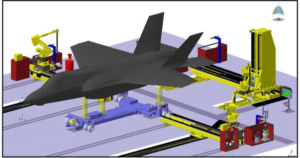
Pic Courtesy: Aerobotix
Aviation is technology intensive. As technologies continue to advance, embracing emerging technologies can help save time, increase safety, and reduce costs.
Some of the technologies that can be useful in aircraft maintenance are:
Artificial Intelligence (AI)
The aviation industry is rapidly changing, and one of the most significant advancements is the implementation of artificial intelligence in maintenance practices. AI has the potential to revolutionise how aircraft are maintained by improving efficiency, reducing costs, and increasing safety.
AI-powered systems can be used for predictive maintenance processes by continuously monitoring aircraft performance and predicting when components need servicing or replacing based on their usage history or environmental conditions.
AI-driven robots are increasingly being employed for inspections and repairs in hard-to-reach areas such as wings or engine nacelles etc.
AI Utilisation and advantages:-
-
- Improving Safety and Reducing Downtime. AI in aviation maintenance has the potential to prevent unscheduled maintenance by real-time data collection and analysis to determine a developing problem before it becomes a safety hazard.
-
- Cost-effective Maintenance Management. AI is highly efficient in detecting even the smallest faults or discrepancies in the aircraft system, which obviates the need for unnecessary preventative maintenance checks, thereby reducing costs. AI algorithms can analyse historical usage patterns, maintenance schedules, and supply chain data to optimize inventory management.
-
- Improved Fleet Management. AI is ideal for managing and optimising a fleet of aircraft. By using predictive maintenance, the maintenance crew can keep the aircraft in better condition, and reduce the turnaround times.
-
- Improved and Accurate Inspection Process. AI enables automated visual inspections of aircraft components, such as engines, airframes, and wings. Using computer vision technology, AI algorithms can analyse images or video footage to detect defects, corrosion, or other issues that may require maintenance. This streamlines the inspection process and enhances accuracy.
-
- Decision-making and Workload Optimisation. With AI, the maintenance crew can predict, get real-time alerts and prevent maintenance issues before they become unmanageable or result in downtime. It can enable quick and efficient decision-making on repairs, reducing overall workload.
-
- In-depth Analysis and Reporting. AI allows for continuous monitoring of several aircraft systems 24/7, providing data collection and analysis that is beyond human capability. The highly complex algorithms, coupled with the extensive database can be used to generate predictions, and reports, and provide detailed information that can be utilised to improve safety, efficiency, and overall operations.
AI can assist maintenance managers and technicians in making informed decisions. By leveraging machine learning and data analysis techniques, AI systems can provide insights into maintenance planning, resource allocation, and fleet performance optimization, ultimately improving operational efficiency.
The Internet of Things (IoT)
The Internet of Things (IoT) is already revolutionising many industries.
IoT-enabled systems can collect data from sensors and transmit it wirelessly to a central control system for analysis. Telemetry is already being used for aircraft and system testing.
This allows the maintenance crew to monitor aircraft performance in real time, enabling them to detect issues before they can become a major problem.
Utilisation of predictive analytics, maintenance teams can anticipate potential issues, and deal with them proactively.
In military aircraft, it is not desirable to transmit vital information all the time. Appropriate switch ON / OFF control would be required in the cockpit.
Another use could be to download the FDR (Flight Data Recorder) data wirelessly, while the aircraft is taxing back to the dispersal. This would reduce the turnaround and on-the-ground time.
Appropriate cyber security measures would be essential for such systems.
Augmented & Virtual Reality
Augmented and Virtual Reality is another technology that is rapidly gaining traction in the aviation industry.
These systems can allow technicians to access real-time information while they are working on an aircraft, such as repair instructions or spare parts lists.
It makes it easier for technicians, improves their efficiency, and enhances safety.
These systems can also be used to provide remote guidance and assistance during repairs, allowing experienced technicians to guide less experienced ones without being physically present.
Computer-aided packages and working models are already being used for training. The AR and VR systems can enhance the quality of training.
Robotics
Robotic systems are already being used in various aspects of aircraft maintenance, such as inspecting parts for flaws or performing simple repair tasks like replacing panels or changing tyres.
In addition, robots can be used for hazardous tasks that would otherwise require humans to enter dangerous areas or work, such as inspecting fuel tanks.
Concluding Thoughts
Emerging technologies are transforming virtually every aspect of aviation maintenance operations—from predictive analytics that allows technicians to anticipate potential issues before they happen to AI robots that make it easier to inspect hard-to-reach areas safely and in a cost-effective manner.
In order for aviation maintenance teams to stay ahead of the curve and remain competitive in this rapidly changing landscape, they must embrace these innovative tools and leverage their capabilities fully in order to maximize their efficiency and effectiveness while minimizing costs and increasing safety margins.
Suggestions and value additions are most welcome
For regular updates, please register here:-
References and credits
To all the online sites and channels.
Disclaimer:
Information and data included in the blog are for educational & non-commercial purposes only and have been carefully adapted, excerpted, or edited from sources deemed reliable and accurate. All copyrighted material belongs to respective owners and is provided only for purposes of wider dissemination.

Has the certification of AI systems commenced by aviation safety and regulating bodies ?
Nice article.
Trying to find out.